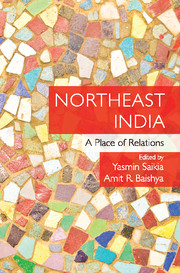Book contents
- Frontmatter
- Contents
- List of Figures
- List of Boxes
- List of Tables
- Acknowledgments
- Introduction
- Section I Contemporary Politics and Issues of Definition
- Section II Creating Presence
- 4 Bonnie Guest House: Fieldwork and Friendship across Borders
- 5 The Muslims of Assam: Present/Absent History
- 6 Ichthyonomics, or Fish and Humans in the Time of Floods: Rethinking Speciation in Assam
- Section III Knowing through Experience
- Section IV Rethinking Politics
- Glossary
- About the Contributors
- Index
5 - The Muslims of Assam: Present/Absent History
from Section II - Creating Presence
Published online by Cambridge University Press: 23 July 2017
- Frontmatter
- Contents
- List of Figures
- List of Boxes
- List of Tables
- Acknowledgments
- Introduction
- Section I Contemporary Politics and Issues of Definition
- Section II Creating Presence
- 4 Bonnie Guest House: Fieldwork and Friendship across Borders
- 5 The Muslims of Assam: Present/Absent History
- 6 Ichthyonomics, or Fish and Humans in the Time of Floods: Rethinking Speciation in Assam
- Section III Knowing through Experience
- Section IV Rethinking Politics
- Glossary
- About the Contributors
- Index
Summary
More than two decades ago, when I met Domboru Deodhai Phukan, the high-priest of the Tai-Ahom community, he admonished me that, instead of researching Tai-Ahom history, I should probe the history of Muslims in Assam because, in his words, ‘the history of your community is disappearing.’ I responded to him in an abstract academic language that history is a subject of critical inquiry for developing awareness of causal and dialectical issues to avoid the mistakes of the past, it is not a search about ‘me’. More than two decades later, I am acutely aware that the ‘disappearing’ history of the Muslims in Assam is an urgent concern. Today, in place of history, Muslims have become a political category. The spectral haunting of the alien ‘Bangladeshis’ who are deemed the representatives of the Muslim problem in Assam is generating fear, distrust and even hatred. Violence has become the tool for finding solutions to the enemy Muslim. Recasting the rich historical past of the Muslim-Assamese with hollow labels, such as ‘Bangladeshi’, ‘illegal’, ‘immigrant’, and so on, is both destructive and ahistorical; this politics needs critical consideration for analysis (Guha, 1980; Hussain, 2000).
Recuperating and rethinking the history of Muslims in Assam is of particular importance today because the Muslim experience provides a window to Assam's blended and fused history – xanmiholi, as described by the littérateur Imran Shah (I will discuss this in greater detail later in the chapter). As a place and people, Assam and the Assamese people had historically evolved and developed through mixing, blending and sharing with multiple communities. The phenomenon produced a crossroads culture, which I would argue involved diffusion of practices sourced from multiple locations that were absorbed in peoples’ lives. This should not be confused with hybridity (Bhabha, 1994) or syncretism (Roy, 1983) but the crossroads communities who were involved in multiple networks created the possibility of continuously expanding the limits of inclusion; the elastic process made Assam's history distinct in the Northeast region.
- Type
- Chapter
- Information
- Northeast IndiaA Place of Relations, pp. 111 - 134Publisher: Cambridge University PressPrint publication year: 2017
- 1
- Cited by



